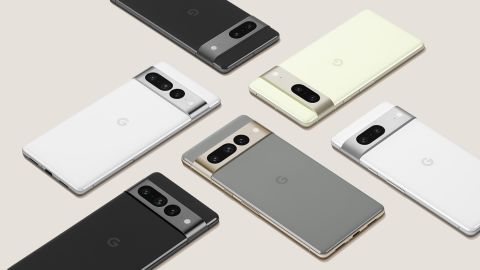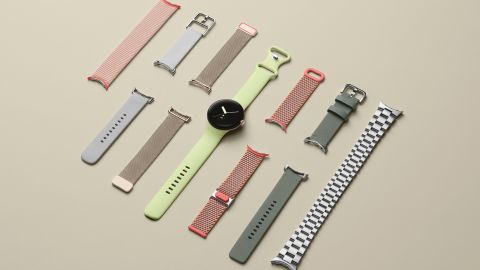Google Unveils New Pixel 7 smartphones and First-Ever Pixel Smartwatch
Google has unveiled its new Pixel 7 smartphone lineup and its first-ever Pixel smartwatch, packed with tracking and health features from its subsidiary Fitbit. At a press event in New York City,...

Google has unveiled its new Pixel 7 smartphone lineup and its first-ever Pixel smartwatch, packed with tracking and health features from its subsidiary Fitbit.
At a press event in New York City, Google showed off the new Pixel 7 and Pixel 7 Pro devices, which largely look the same as the year prior but with new camera features, an improved screen and battery, and an updated Google Tensor processor.
While many of the updates are iterative, the lineup will likely appeal to tech enthusiasts who want the latest version of Android and an alternative to Apple or Samsung smartphones, as well as those who haven’t upgraded their Pixel device in a few years.
The 6.3-inch Pixel 7 features a glass back, aluminum frame and a sleek band on the back with black cutouts for the camera system. Its always-on OLED display allows for quick checking of widgets that highlight useful information, such as baggage claim details at the airport or when packages are arriving (not unlike what’s been recently made available on the new iPhone 14 line with the lockscreen).
Google (GOOG) said the Pixel 7’s screen is now 25% brighter for visibility indoors, and the device can go a full day on a single charge (or 72 hours when on extreme battery saver mode). It comes in three colors – obsidian, snow and lemongrass – and starts at $599, or $200 less than a baseline iPhone 14 with the same amount of storage.
“We want people to give Pixel a try, so while phones in this tier typically start at $799, we’re starting the price at $599,” Brian Rakowski, Google vice president of product management, said on stage during the event.
The larger 6.7-inch Pixel Pro – which comes in a matte aluminum finish – features an always-on display, the same long-lasting battery as the Pixel 7 and a new triple rear camera system, which includes a 5x telephoto lens, 30x super resolution zoom and an upgraded ultrawide lens. The ultrawide lens comes with autofocus capabilities to support new features including Macro Focus that picks up on fine details.

Both models run on Google’s new Tensor G2 processor, which powers the device’s machine learning and speech recognition capabilities, and several camera features. With Night Sight, for example, the camera now processes photos twice as fast. The tech also drives Cinematic Blur, a new dramatic blurring effect for videos.
A new accessibility feature called Guided Frame helps visually impaired users take better selfies by vocally instructing them to move the device in specific directions. Google also announced updates to making calls, including cutting down on background noise and the ability to transcribe audio messages into text messages.
The Pro model, which comes in obsidian, snow and hazel, starts at $899. Pre-orders start on Thursday for both models and the devices hit shelves on Thursday, October 13.
Google’s Pixel line remains a niche product. Its global market share for smartphones has never surpassed 1% on an annual basis, according to data from IDC Research. Google also limits sales to only a handful of countries, so keeping the volume low has been strategic as Google remains predominantly a software company with many partners running Android. (Google said the Pixel 7 line, however, will launch in sevral new countries, including India, Denmark, Sweden and the Netherlands.)
Google won’t likely take much market share away from Apple with these Pixel updates, as iPhone owners are known to be brand-loyal. Other Android smartphone makers, however, such as Samsung or smaller Chinese manufacturers may feel the pressure from consumer interest in Google hardware, according to Ben Wood, an analyst with CC Insight. “But given the incremental updates, it’s possible there will be less excitement than there has been in the past,” he said.
At the event, Google also teased another early look at its upcoming Pixel tablet, which will feature the Tensor G2 processor, and is expected to launch in 2023.
But one area where Google could make a greater impact this year is with the introduction of the Pixel watch. It is Google’s first wearable that plays up Fitbit’s strengths in health, fitness and wellness since closing its $2.1 billion acquisition of the smartwatch company early last year. Until now, Google had been quiet about how the Fitbit brand would integrate with its Wear OS software.

The new 41 mm Google Pixel Watch features a circular, domed-shaped Gorilla Glass display that’s scratch- and water-resistant. It promises up to 24 hours of battery life and is compatible with Android 8 and newer devices. Built with Fitbit’s tracking capabilities, the Pixel Watch can monitor a user’s heart rate and sleep quality, offers 40 workout modes, and learns user behavior over time.
The device also assists with emergency SOS and supports a handful of Google services, including Google Wallet, Gmail and calendar updates, as well as sending messages and talking over 4G. The Pixel Watch comes in black, gold and silver finishes. It will cost $349 for Bluetooth and $399 for 4G LTE.
“Pixel Watch poses zero threat to the Apple Watch, but it has an important role to play in raising the awareness of smartwatches for Android smartphone owners,” Wood said. “Given the success of the Apple Watch, there has to be a bigger market for smartwatches in the Android segment and together with Samsung’s Galaxy Watch, the new Pixel Watch should be a key driver for growth.”
It may take the Pixel Watch a few generations to catch up to the Apple Watch in terms of usability, however, as Apple’s smartwatch is now in its ninth iteration. But coupled with the Fitbit acquisition and the formation of Wear OS in collaboration with Samsung, Google is showing its greater commitment to the smartwatch market and perhaps hoping the time may finally be right for it.









No Comment! Be the first one.